NIL
Pay to play: Will Snowden on NIL, agents, the portal, and the shifting sands of college recruiting
PROVO — As college football continues to evolve in the wake of the NIL era, the traditional model of recruiting, development, and player loyalty is being fundamentally reshaped. At the intersection of this transformation is Will Snowden, the founder of Alpha Recruits, which is a Utah-based organization that helps young athletes navigate the college football […]
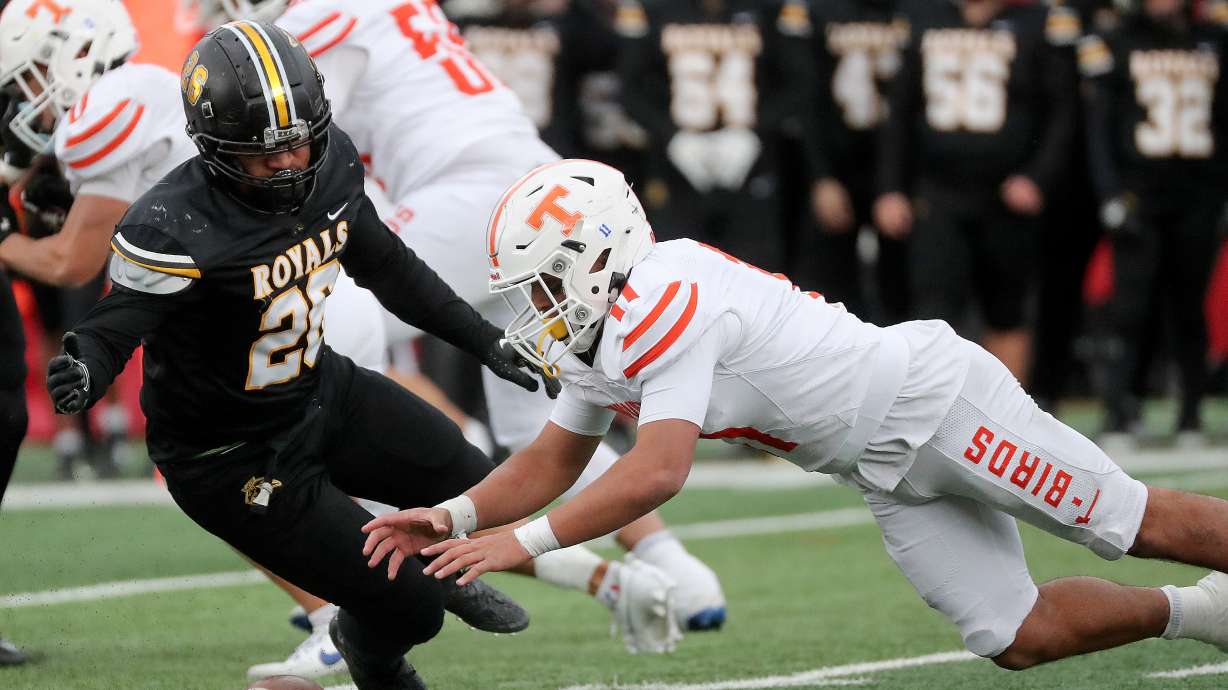
PROVO — As college football continues to evolve in the wake of the NIL era, the traditional model of recruiting, development, and player loyalty is being fundamentally reshaped.
At the intersection of this transformation is Will Snowden, the founder of Alpha Recruits, which is a Utah-based organization that helps young athletes navigate the college football recruiting process.
Snowden has been a firsthand witness to the sweeping changes that NIL, the transfer portal, and increased agent involvement are bringing to the sport, and he doesn’t see things stabilizing anytime soon.
Where once recruiting was a long-term investment — identifying and developing young talent from the high school level — many programs now operate more like free-agent hunters.
The influx of NIL money and the wide-open nature of the transfer portal have turned college football into a high-stakes marketplace, and agents are no longer limited to post-college careers; they are now very much part of the college game, actively recruiting players still in school.
“With college players being paid, a lot of the top agencies are attacking and going to get these players now,” Snowden said in a recent interview with ESPN 103.9 and 98.3 The Fan. “These agents are getting a ton of information about opportunities … all of a sudden, there’s information about what that kid might be worth if he were to get into the portal.”
Free market free agency
The power that agents now wield is remarkable. They serve not just as advisors but as market makers — negotiating NIL deals, influencing transfer decisions, and even initiating contact between schools and players, directly or indirectly.
While some argue this offers athletes much-needed empowerment, others like Snowden are deeply concerned about the lack of regulation, oversight, and long-term planning within this fast-evolving system.
The real winners in this new structure, according to Snowden, are often players who have already proven themselves at the college level and are willing to jump ship. These players, especially those with multiple years of eligibility left, can command significant NIL offers simply by entering the portal and creating a bidding war among programs.
“Most top players are worth more in the portal than they are at their (current) school,” he said. “I don’t see it changing anytime soon because there is no collective bargaining; there is no union. I’m interested to see how it all plays out.”
High schoolers are not high priority
For college coaches, roster management has become chaotic and unpredictable. For high school athletes, it’s even worse. With programs focused on experienced portal players, many high school seniors are being left behind, even when their talent and potential clearly warrant scholarship consideration. Snowden said the impact has been staggering.
“I’ve seen a 75% drop,” Snowden said, referencing the decline in scholarship offers to high school players. “I’m going to tell you something that really upset me. I have a few guys I’m trying to place who are high school seniors — very good, talented. I’m speaking to an (FCS) program and they say, ‘We need a preferred walk-on backer. He’s going to have to pay for his school first.’
“They said, ‘It has to be a portal guy.’ I said to myself, OK, this is what’s really broken. Schools want to complain about the portal but then all they’ll take is the portal.”
The contradiction is glaring.
College programs bemoan the destabilizing effects of the transfer portal but simultaneously rely on it as their primary method of roster building.
For young players dreaming of college football, this has made the process murkier and more discouraging than ever. The notion of being “recruited and developed” is increasingly being replaced by “wait your turn and hope someone leaves.”
Familial ties and third party connections
Snowden’s recruiting work in Utah offers a clear lens into these shifting dynamics. The state has a close-knit football community, where families often have ties to multiple local universities. Loyalty, tradition, and development used to matter.
But even in a place so steeped in football culture, the new economics of the sport are reshaping how decisions are made and where players end up.
“In Utah, it’s a very small community,” he said. “There aren’t many families that don’t have connections to every school in the state. You have so many families that are split.”
These internal divides reflect broader national trends. NIL and the transfer portal have blurred the lines between amateurism and professionalism; and for many players, the decision to transfer isn’t about loyalty, for some it’s about opportunity, and market value.
Families, third-party representation, and agents see a better deal elsewhere and nudge players into the provocative portal. For others, it’s due to the new transactional relationships between programs and players.
Many players recently have been gently encouraged to enter the portal by coaches seeking to free up scholarships or refresh rosters.
“This is the reality. The portal’s a very interesting place,” Snowden said. “Many of the kids that are in the portal were told to enter the portal. The kids are getting hip to the game. … ‘I gotta do what’s best for me.'”
Transactional vs. transformational
Once rare, transferring is now increasingly common. When relations turn transactional, there is a survival instinct that kicks in that reminds players and their families to make the most of their short college window.
Programs, efforting to retain talent, need a strong message and competitive NIL to retain them. Retaining talent no longer depends on just building a strong team culture, winning as a team or offering playing time. It now requires programs to understand each athlete’s financial and long-term personal calculus.
“It just comes down to the kids, their situation, the commitment to the program, their role inside the program as well,” Snowden said.
At its core, Snowden’s work is still about helping young athletes achieve their dreams. But that dream — of signing on national signing day, wearing a college jersey, and slowly working into a starting role — is fading fast. The system is becoming more transactional, and unless structural reforms come into play, the future of high school recruiting could be in jeopardy.
“I’m focused on helping high school kids live out their dream of playing college football,” he said. “And it’s getting harder and harder — not by the day, but by the second.”
The Key Takeaways for this article were generated with the assistance of large language models and reviewed by our editorial team. The article, itself, is solely human-written.
NIL
Recruit at center of NIL arguments
Jackson Cantwell Commitment: Miami Hurricanes football lands top recruit Nixa High School’s Jackson Cantwell picked Miami (Florida) as his college destination during a ceremony on Tuesday afternoon in Nixa. Since committing to the Miami Hurricanes football program, Nixa offensive tackle Jackson Cantwell has been the source of much online argument because of national reports of […]


Jackson Cantwell Commitment: Miami Hurricanes football lands top recruit
Nixa High School’s Jackson Cantwell picked Miami (Florida) as his college destination during a ceremony on Tuesday afternoon in Nixa.
Since committing to the Miami Hurricanes football program, Nixa offensive tackle Jackson Cantwell has been the source of much online argument because of national reports of what he’ll receive in Name, Image and Likeness compensation.
Some reporters covering the Hurricanes’ football program believe such reports of his compensation resulted from intentional leaks by the other programs pursuing the top-ranked recruit. Cantwell’s family has downplayed the extent of the compensation and its impact on his decision to commit to the Hurricanes.
“It’s just a blessing to get paid to play the game I love,” Cantwell said Tuesday when asked directly about NIL, while also praising the work done by his agent, Drew Rosenhaus. “There are so many people who dream about getting to do that. The NFL is usually the end-goal, and it is for me as well.”
Jackson Cantwell calls out national college football reporter
National college football reporter Pete Nakos of On3 Sports reported a week before Cantwell’s decision that Miami had offered him a $2 million NIL deal, which was said to be the most of any school.
While Cantwell talked up his relationship with the Miami coaching staff and its ability to develop offensive linemen into NFL prospects, the report still led many to believe the only reason Cantwell picked Miami over schools like Georgia, Oregon and Ohio State was because of money.
In a one-on-one interview with DawgNation, a Georgia website that attended Cantwell’s commitment, Cantwell called out Nakos for the report.
“It’s not the same narrative that people like Pete Nakos are pushing right now,” Cantwell said. “The false narrative that that’s why I’m choosing… I think relationships won out with Miami.”
Miami Hurricanes football reporters call out report
Miami insiders were also quick to call out the reports.
“When you see a story like this, you ask yourself where it came from,” a report by CanesInSight said. “The agenda here is crystal clear, and Georgia knows how to play this game. It’s ‘let’s make this seem like that if he goes to Miami, it’s only because of money.’ Then, if he chooses Miami, then it’s that he’s following the bag, and it’s a stigma on the kid. It’s a strategic leak by people who want him in Georgia.”
Mike Ryan, an executive producer on The Dan Le Batard Show with Stugotz and owner of CanesInSight, doubled down against the report after Cantwell committed.
“A lot of bad leaks started sprouting out last week about Miami having the most aggressive NIL offer,” Ryan said on X. “Always a pretty solid indicator other schools feel like they’re losing a battle. It’s weird when Miami loses a recruiting battle to Oregon or UGA, it’s never about NIL somehow.”
Jackson Cantwell said relationships led him to Miami Hurricanes football
Throughout his recruitment, Cantwell, a 6-foot-8, 320-pounder, spoke at length about his relationship with and appreciation for Miami coach Mario Cristobal and offensive line coach Alex Mirabal, calling them the best developers of offensive linemen in the nation. He often pointed to their track record, specifically the rise of offensive tackle Penei Sewell, now one of the better linemen in the NFL.
Miami should have multiple offensive linemen drafted in the 2026 NFL Draft, including Francis Mauigoa, who is being touted as a first-rounder.
“Whenever you have Mario Cristobal and Alex Mirabal, you know you’re gonna be in a good spot and you’re going to be developed by some of the best out there,” Cantwell said. “They’re producing guys, and they’re really successful. The guys up front have turned their program into a winner. I’m just excited to be a part of that.”
Still, the unknown amount of money the 16-year-old will make has been the source of argument, ignoring that Georgia, Oregon and Ohio State also likely had large sums on the table.
Jackson Cantwell recruiting coverage
NIL
Reece Potter knew he would commit the second Kentucky called: “It’s a dream come true.”
Miami (OH) transfer Reece Potter didn’t know what to expect when he entered the portal in late March — but he certainly didn’t expect things to unfold the way they did in April, then early May. His phone wouldn’t stop ringing, hearing from programs and coaches he never would have imagined would be prioritizing him […]
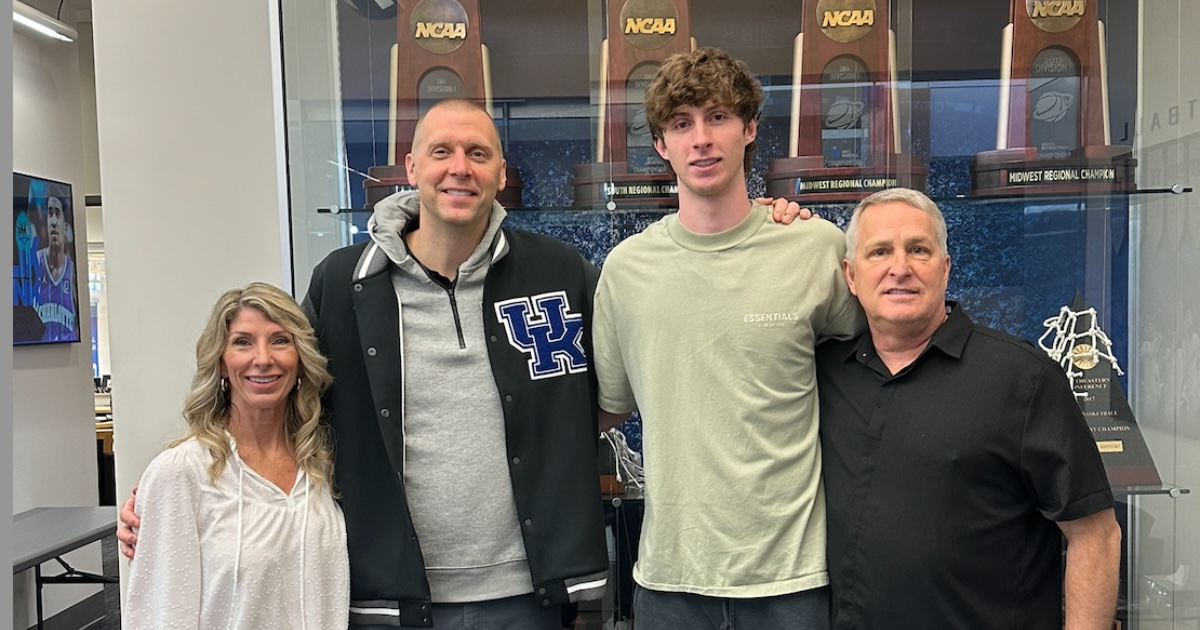
Miami (OH) transfer Reece Potter didn’t know what to expect when he entered the portal in late March — but he certainly didn’t expect things to unfold the way they did in April, then early May. His phone wouldn’t stop ringing, hearing from programs and coaches he never would have imagined would be prioritizing him after two seasons in the MAC.
Among them? North Carolina, Washington, Louisville and UConn.
“It was really crazy. The phone was always ringing with different people talking to you, trying to give their pitch on why you should go to their school,” he told KSR. “It was crazy. It was really cool hearing from all these schools, the Hubert Davises and Dan Hurleys — I mean, it’s just wild. There were some people that I grew up watching and you watch on TV every day. It’s wild for those people — you get that call and it says ‘Maybe: Hubert Davis’ or however it was marked. It’s wild for sure, it was fun.”
Then the text messages and phone calls came in. At that point, it was over.
“Once Kentucky called me, it was like, ‘It’s time, I’m done talking to these people. Let’s get to the business,’” Potter said.
As a Lexington, the opportunity to return home and play for the winningest tradition in college basketball history was too much to pass up. Sure, other schools offered more playing time (and maybe more cash), but Kentucky was selling something money can’t buy.
The process wasn’t immediate, though. He knew immediately he wanted to wear the blue and white, but his parents wanted him to take a deep breath and think through the decision, not committing out of emotion.
“When Kentucky called me, it was a dream come true, but I still had to make the best decision for myself,” he told KSR. “Always in the back of my mind it was like, ‘You’ve got to go there. You have to go there.’ But my parents were very supportive, they were like, ‘Just take your time, just kind of see what’s all out there.’
“Once they contacted me, I took a week to settle down a little bit. Right away, I was like, ‘Yeah, yeah, I’m going there. I’m going there.’ My dad was like, ‘Relax, relax. I know that’s your dream school, but just take a week for yourself. Really understand what that would mean for you, if that’s the decision you want.’”
Then a week went by and he was just as excited then as he was when the process started, confirming what he knew from day one: Kentucky was home.
“So after that week, I kind of got down to contacting the other schools, like, ‘What’s the deal here?’ I always knew I was going here, so it was easy after that,” Potter said. “I called my parents, I was like, ‘I’m going there.’ They were like, ‘Yeah, we always knew you were gonna do that, but we just wanted you to make the best decision for yourself.’ So I’m glad it’s over, and I’m glad to be able to be a part of this.”
How is he feeling a little over a week following his commitment, the dust now settled ahead of move-in to open June?
“The decision was a dream come true, for sure. All of the hecticness is out of the way, so now, I’m able to relax and kind of just enjoy this decision I was able to make,” he continued. “It’s setting in, for sure. It’s still a dream come true. I
“‘m just waiting to put on the jersey for the first time and be able to walk out to Rupp Arena. That’s going to be the biggest thing.”
Once a kid watching Kentucky as a fan, he now gets to represent his hometown as a Wildcat himself. Quite the dream come true.
NIL
The MyPerfectFranchise Daily Recap: The bigger picture in UGA recruiting
Here is the May 15 edition of The Daily Recap presented by My Perfect Franchise. The bigger picture Rivals’ Adam Gorney excellently laid out the practical way to approach what happened between Georgia and offensive lineman Jackson Cantwell, who committed to Miami on Tuesday. Most felt Cantwell was going to choose Georgia up until the […]
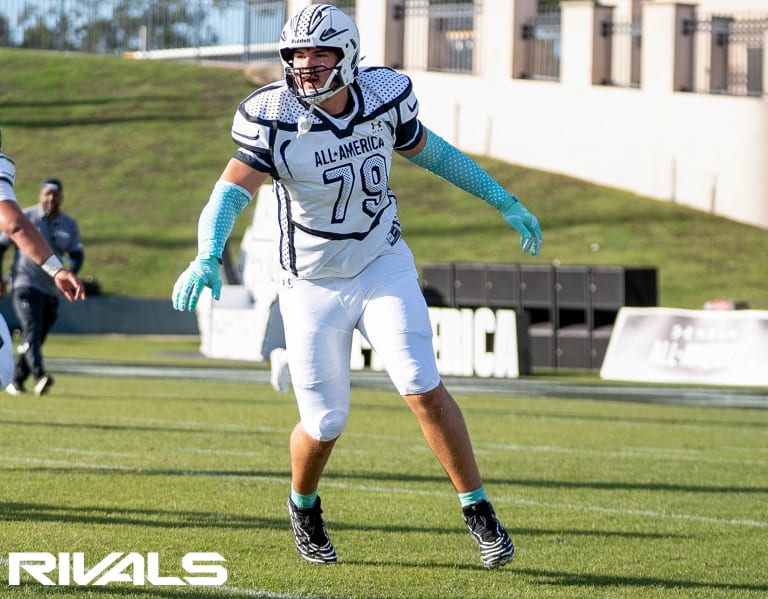
Here is the May 15 edition of The Daily Recap presented by My Perfect Franchise.
The bigger picture
Rivals’ Adam Gorney excellently laid out the practical way to approach what happened between Georgia and offensive lineman Jackson Cantwell, who committed to Miami on Tuesday.
Most felt Cantwell was going to choose Georgia up until the day of his commitment ceremony. However, his relationship with the Miami coaching staff and a hefty NIL compensation package ended up swaying the Hurricanes’ way. While the recruiting loss stings, Gorney pointed out that head coach Kirby Smart is not going to put that kind of money on the line for one player.
While talent is key in college football, there are many other factors involved. After all, no one player is bigger than the overall concept of a team.
“Smart is just not going to push his entire stack into the middle on one player, say, Cantwell,” Gorney wrote. “If the Bulldogs can circle back on five-star Immanuel Iheanacho or make a less-costly run at four-stars Carter Scruggs, Malakai Lee, Ekene Ogboko and others, that might be more rewarding in the end. At least, that’s the bet Smart is making.
“With more NIL money freed up as Cantwell packs his flip flops for South Beach, Georgia can spread more around to multiple offensive linemen, to four-star tight end Mark Bowman, to four-star all-purpose back Derrek Cooper, to five-star linebacker Tyler Atkinson and others.”
There are numerous approaches to building a roster. Smart’s preferred method in the NIL era is to get as many talented and motivated players on his team. Paying a large sum on one player is going to cut into what the program can afford on other players.
In addition, back in March, Smart said what he wants to see out of young players in his program.
“I want to see the fire,” Smart said. “I want to see the passion, the energy. I want to see who wants to be a good football player. Who really cares about this game. Like, they care more about the game than they do their NIL revenue stream. Like if you really, really, really care about the game and want to be good it doesn’t matter about any kind of money. It matters how I play the game and more and more we’re seeing across college football, the purest, the ones that care about the game the most, play the hardest.”
“And usually the team that plays the hardest wins. I know everybody thinks it’s just whoever is more talented but there is a whole lot to how hard you play and how much you care about it.”
Still a great offensive line
Heading into the 2025 season, Georgia figures to field a great offensive line. In fact, ESPN analyst Cole Cubelic believes the Bulldogs have the best offensive line in the SEC.
“I think last year is a bit of an anomaly for Georgia,” Cubelic said. “Right this second, I am going with Georgia as the No. 1 group. I think injuries got in the way.”
Cubelic is confident in the bulk of Georgia’s line, including center Drew Bobo, who is set to replace Jared Wilson as a starter. Interestingly enough, he said that Earnest Greene is among the few question marks of the group.
“I am going to give Earnest Greene a little bit of a pass, …” Cubelic said. “I’ve seen great football in this kid. It’s out there. The film of Earnest Greene being dominant is there. Consistently can it come back? Maybe, if it does, I think Georgia’s got a chance to be the best offensive line in the SEC.”
Also on UGASports
Film don’t lie: Drew Bobo.
Ryland Zaborowski continues to progress from his elbow injury.
Previewing No. 4 Georgia’s upcoming baseball series against Texas A&M.
One last homestand
Are you a displaced corporate executive or want to put your career in your own hands? Or are you an experienced entrepreneur wanting to diversify? Well, Andy Luedecke can help!
Andy is a longtime Rivals board member, diehard college football fan and franchise veteran. He owns multiple franchises and businesses and uses his expertise to help others find their American Dream through a very thorough and FREE consultation process.
Call Andy, put your life and career in your own hands. It’s 100% free, so what do you have to lose?!!
Find Your Perfect Franchise at MyPerfectFranchise.Net
Contact Andy Luedecke anytime at: andy@myperfectfranchise.net or (404) 973-9901.
NIL
Ohio legislator authors bill to curtail Ohio State noon kickoffs
In recent years, Ohio State football fans have become increasingly frustrated with the high volume of noon kickoffs their beloved Buckeyes have been forced to play. One Ohio legislator is hoping to remedy that. Ohio Representative Tex Fischer has authored a bill that would prohibit Ohio State from playing marquee games before 3:30 p.m. ET. […]

In recent years, Ohio State football fans have become increasingly frustrated with the high volume of noon kickoffs their beloved Buckeyes have been forced to play.
One Ohio legislator is hoping to remedy that.
Ohio Representative Tex Fischer has authored a bill that would prohibit Ohio State from playing marquee games before 3:30 p.m. ET. A notable exception would be for the Buckeyes’ annual rivalry game against Michigan, which traditionally kicks off at noon.
Since Fox, one of the Big Ten’s television partners, introduced its “Big Noon Saturday” window ahead of the 2019 season, Ohio State has become a fixture of the earliest broadcast time of the day. The Buckeyes have played 35 noon games since the start of the 2019 season, including seven last year on their way to their first national championship in a decade. Each of Ohio State’s final six regular-season games began at noon, three of which came at home.
The bill, as written, would prevent any game from being played in the state of Ohio if it meets both of the following criteria:
- One of the competing teams is a football team from a state university
- Both teams are ranked in the top 10 of the Associated Press poll of the FBS
Of note, only one of the Buckeyes’ 2024 games would have fallen under that criteria: The Nov. 23 meeting with Indiana, a game in which the Buckeyes and Hoosiers were ranked No. 2 and No. 5 in the AP Top 25, respectively. Ohio State played only one other top-10 team in the noon slot against No. 3 Penn State, though that was on the road.
If the bill becomes law, the ramifications for skirting it would be steep. The legislation states that if a game starts before 3:30 p.m., the Ohio attorney general will impose a fine of $10 million against either the host team’s conference (the Big Ten) or the television network, whichever one scheduled the earlier kickoff.
While noon kickoffs offer fans, particularly those watching from home, time to take in other college football games from across the country later in the day, they’re generally an annoyance for fans attending the game in person, forcing them to wake up earlier in the morning and giving them less time to tailgate.
When Fox debuted “Big Noon Saturday,” it was a way for the network to air a marquee matchup during what’s typically a barer early slate rather than having to compete against the SEC’s longstanding 3:30 p.m. game on CBS or ESPN’s primetime game (CBS now primarily airs a Big Ten game during the 3:30 p.m. slot as part of a new media rights deal with the conference). Fox adds some pageantry to its noon kickoff by bringing the network’s pregame show, “Big Noon Kickoff,” to the site of the game, much in the same way ESPN does with “College GameDay.”
Unfortunately for Ohio State, the Big Ten’s most consistently successful program since “Big Noon Saturday” launched six years ago, that interest in putting the Buckeyes in marquee time slots for Fox often means receiving a disproportionate share of early start times.
The bill hasn’t yet appeared on the Ohio legislature database, but text of it was published Thursday by journalist D.J. Byrnes of The Rooster.
NIL
Kirby Smart Paints Grim Picture For College Sports in Latest Statement Regarding NIL
Georgia Bulldogs head coach Kirby Smart paints a concerning future for college athletics with his latest statement regarding NIL. College football head coaches are constantly forced to navigate new issues revolving around the league and have seen the sport undergo some massive changes over the past decade. But no other change appears to be more […]

Georgia Bulldogs head coach Kirby Smart paints a concerning future for college athletics with his latest statement regarding NIL.
College football head coaches are constantly forced to navigate new issues revolving around the league and have seen the sport undergo some massive changes over the past decade. But no other change appears to be more headache-inducing than the emergence of NIL.
While the policy change has been viewed as an overall positive, it has brought forth its fair share of issues. Many of which have created financial ripples throughout college athletics. Georgia Bulldogs head coach Kirby Smart shared his thoughts on the issue and expressed his desires for the sport moving forward.
“I just want to be able to have a freshman come in and not make more than a senior and I’d like for other sports to be able to still survive.” Said Smart. “You know, we’re on the brink of probably one to two years away from a lot of schools cutting sports.”
While football is a massive sport that produces millions of dollars in revenue each season, other sports may be forced to go by the waist-side due to the increase of competitive prices when it comes to fielding a football roster.
Unfortunately, there does not seem to be a simple fix for the issues that the NIL era of college football presents, and the sport (along with other college athletics) will likely continue to undergo a litany of changes in the near future.
NIL
'We're excited'
The explosion of the transfer portal and name, image and likeness deals have transformed the landscape of collegiate sports. Superstar athletes are frequently plucked from their teams, lured by promised fortune. But with only one new transfer on UCLA’s roster – graduate student outfielder Jessica Clements, who came from Cal Poly in August – coach […]

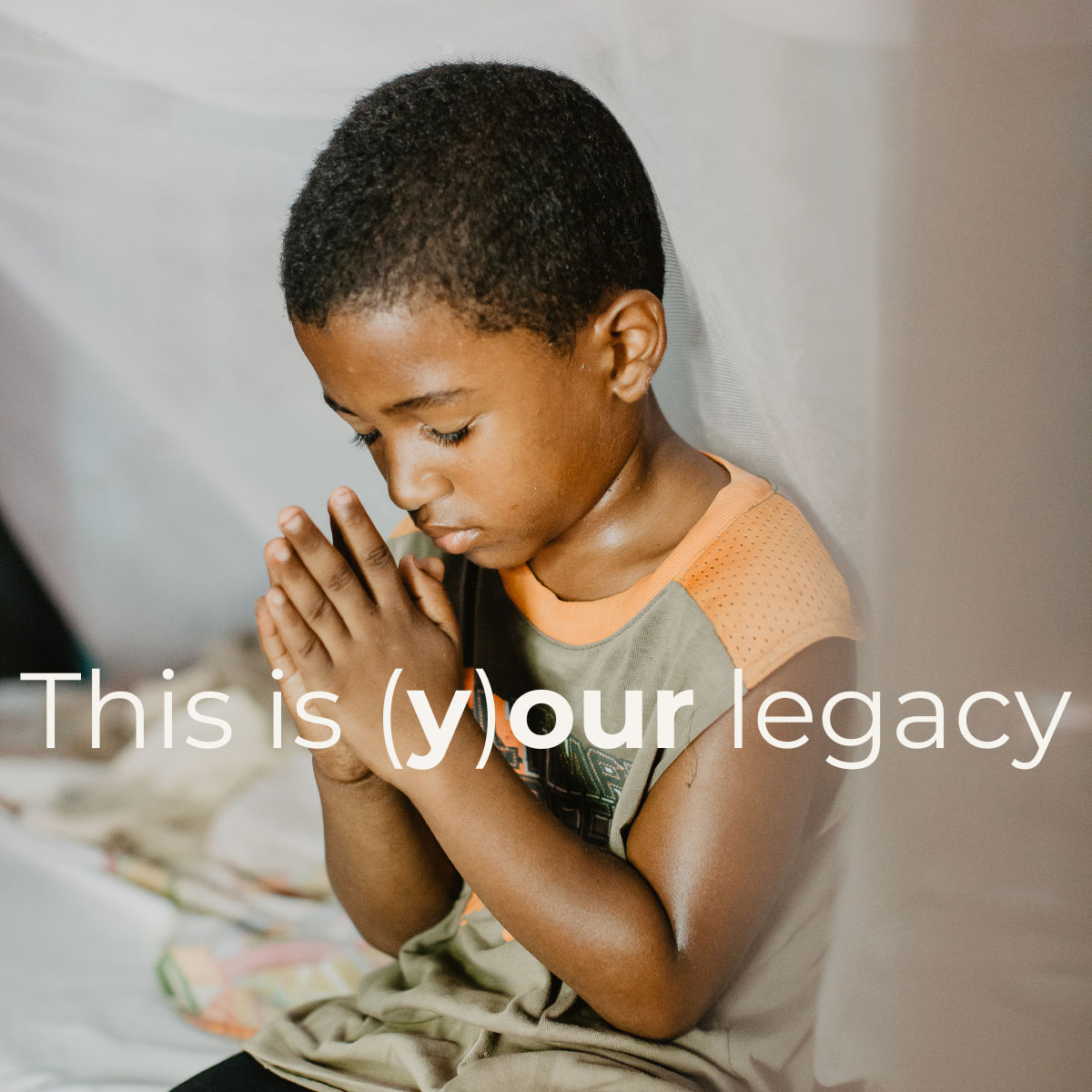
The explosion of the transfer portal and name, image and likeness deals have transformed the landscape of collegiate sports.
Superstar athletes are frequently plucked from their teams, lured by promised fortune.
But with only one new transfer on UCLA’s roster – graduate student outfielder Jessica Clements, who came from Cal Poly in August – coach Kelly Inouye-Perez is building a culture that cannot be bought.
“It’s different. I’m building a program where I have freshmen that are playing,” Inouye-Perez said. “We’re a program that develops. We’re a program that likes to level people up. We’re a program that passes along leadership.”
After losing five of its nine starters from its 2024 postseason run, No. 9 seed UCLA softball (49-10, 17-5 Big Ten) will play its first game of the 2025 NCAA tournament against UC Santa Barbara (34-24, 17-10 Big West) on Friday at Easton Stadium. The contest marks the 11th consecutive season the Bruins will host the Los Angeles Regional.
Tasked with filling the void of a veteran-heavy 2024 roster, the Bruins sported six freshmen in the starting lineup in 2025 before an arm/shoulder injury sidelined shortstop Aleena Garcia, causing her to redshirt the 2025 season.
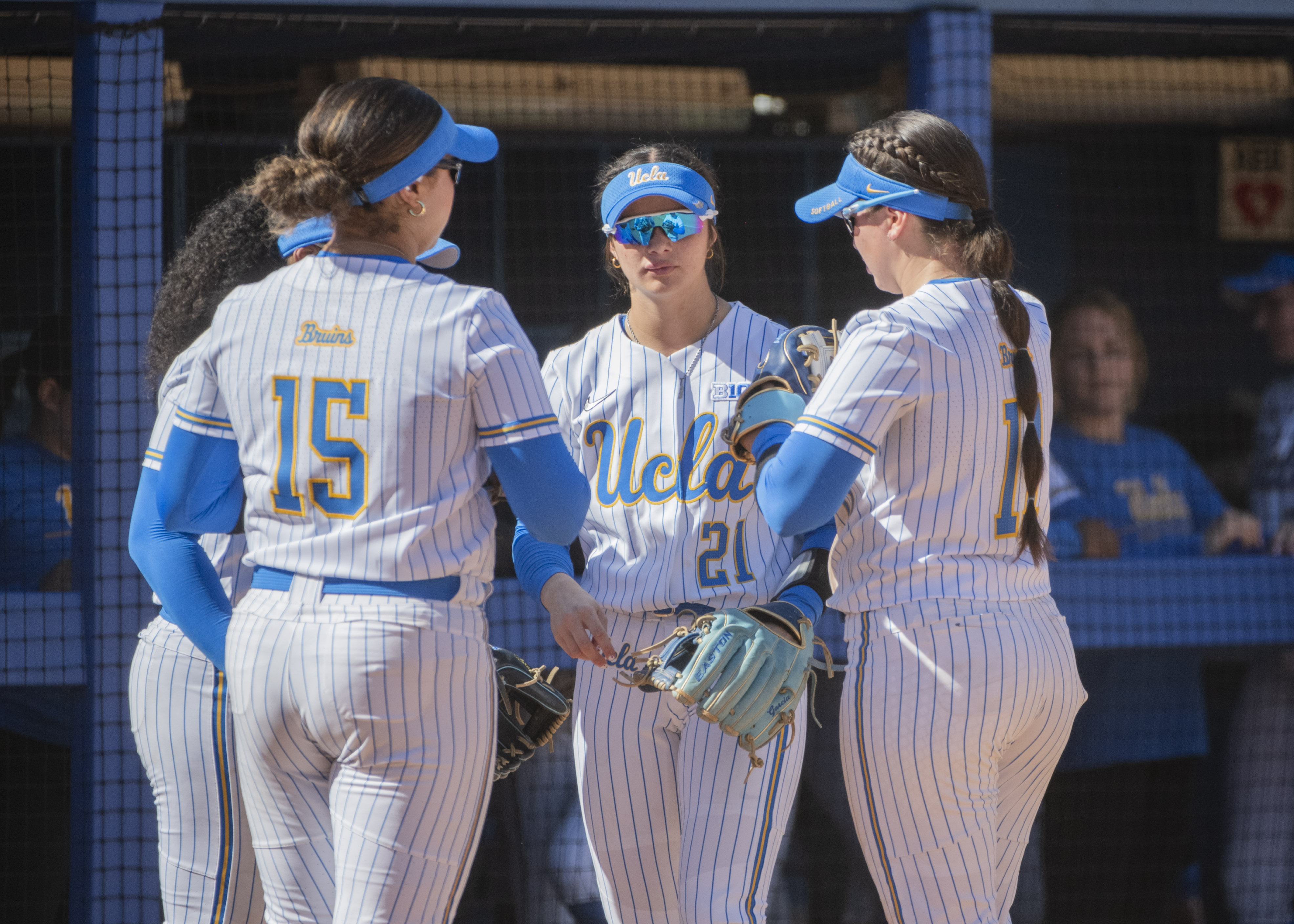
Freshman outfielder Rylee Slimp’s walk-off single in the Big Ten tournament quarterfinals proved she is able to come through in high-pressure situations, while freshman pitcher/utility Addisen Fisher’s 2.43 ERA leads all UCLA pitchers who have thrown at least 100 innings.
Although the freshmen’s paths to Westwood featured high-level competition, the intensity of the NCAA tournament is one that is impossible to replicate.
But even with several new faces on the squad, UCLA’s trip to Oklahoma City last season equips returning players with experience to pass down to their younger teammates.
“Our junior class – we’ve been to the (Women’s College) World Series,” said junior infielder Jordan Woolery. “We have experience there and some good postseason experience from last year, too, so taking that into this year and just teaching the freshmen.”
As two of the veterans on the team, Woolery and junior utility Megan Grant – both top-25 finalists for the USA Softball Collegiate Player of the Year award – were the only two Bruins to record hits in their elimination game against then-No. 1 seed Oklahoma last season.
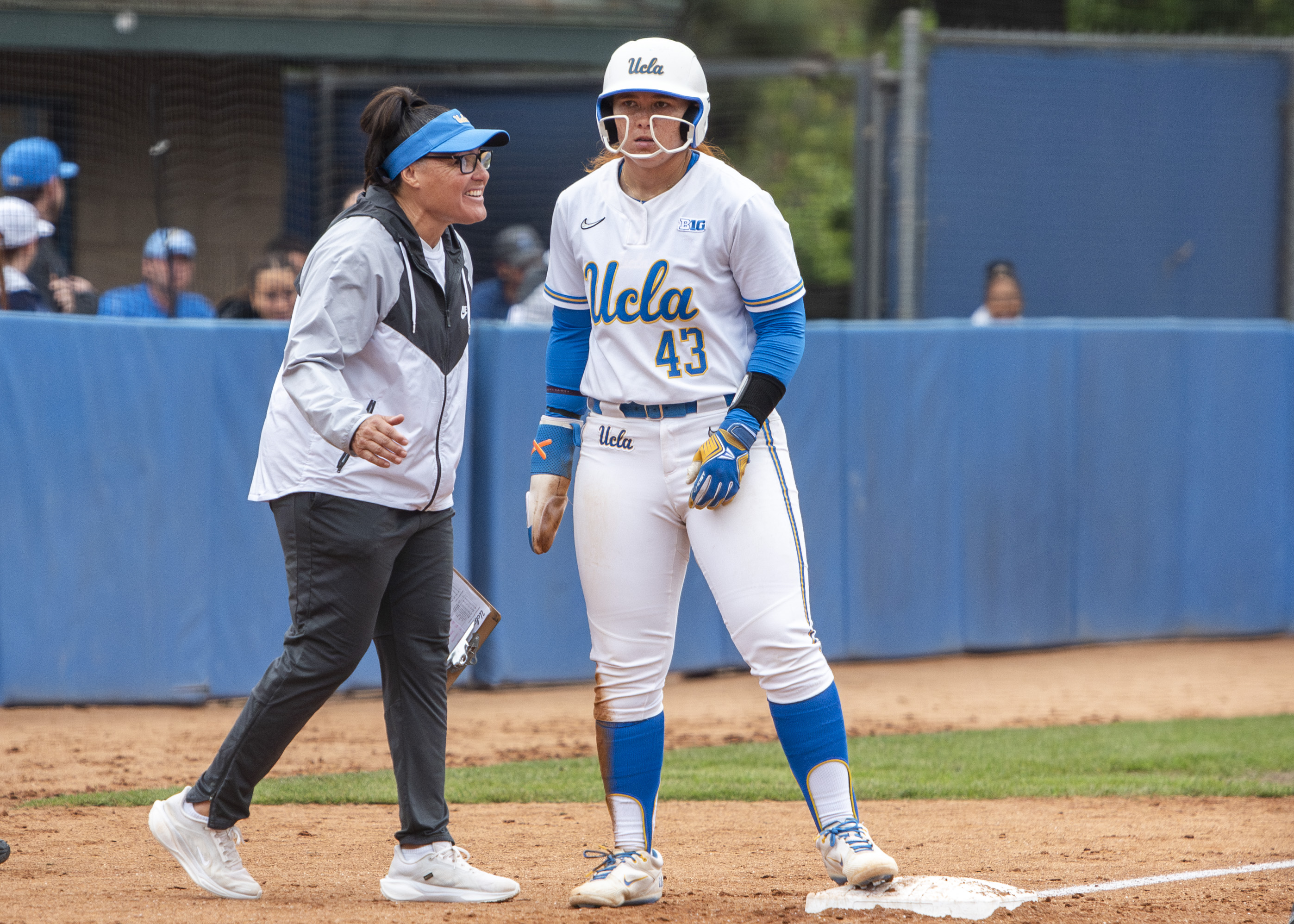
And this season, Woolery and Grant became two of 12 Bruins in program history to hit 20-plus home runs in a single season. Senior utility Savannah Pola has also made statements, improving her batting average from .241 in 2024 to a team-leading and career-high .439 in 2025.
However, the Bruins’ bats have seemed to go cold in the postseason, falling 2-0 in the Big Ten tournament finals against No. 8 seed Michigan. The week prior, Northwestern upset UCLA, run-ruling the Bruins 8-0 in the series opener and ultimately claiming the final regular-season series with a win on Senior Night in Westwood.
Defensively, UCLA’s .979 fielding percentage ties for the fifth best in the NCAA, led by Pola’s perfect 1.000 fielding percentage at second base. Additionally, sophomore pitcher/outfielder Kaitlyn Terry and junior pitcher Taylor Tinsley combined to throw for all 49 innings of the NCAA tournament last season, emerging as one of the top pitching duos in the nation.
The NCAA tournament presents the Bruins with another chance to bring back some hardware this season, and it all starts on their home field.
“We’re excited to play together. We’re just grateful for every day we have, every game,” said redshirt sophomore catcher/utility Alexis Ramirez. “But we’re excited to be at home, and we want to see the stands packed, and hopefully we can get Easton rocking.”
-
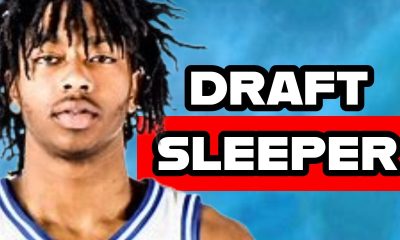
 College Sports2 weeks ago
College Sports2 weeks agoDuke basketball's Isaiah Evans on 2025 NBA Draft early entry list
-

 Fashion2 weeks ago
Fashion2 weeks agoHow to watch Avalanche vs. Stars Game 7 FREE stream today
-

 High School Sports7 days ago
High School Sports7 days agoWeb exclusive
-

 Sports7 days ago
Sports7 days agoPrinceton University
-

 Sports6 days ago
Sports6 days ago2025 NCAA softball bracket: Women’s College World Series scores, schedule
-

 Motorsports1 week ago
Motorsports1 week agoBowman Gray is the site of NASCAR’S “Advance Auto Parts Night at the Races” this Saturday
-

 NIL1 week ago
NIL1 week ago2025 Big Ten Softball Tournament Bracket: Updated matchups, scores, schedule
-
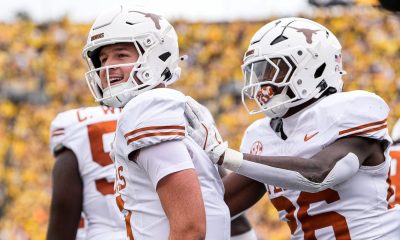
 NIL3 weeks ago
NIL3 weeks agoHow much money will Quinn Ewers make in NFL? Salary, contract details
-

 Motorsports1 week ago
Motorsports1 week agoMOTORSPORTS: Three local track set to open this week | Sports
-
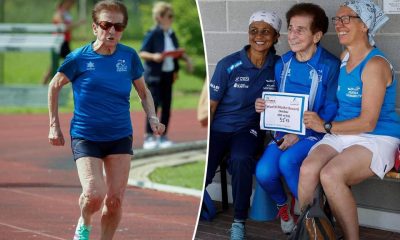
 Sports3 weeks ago
Sports3 weeks agoItalian woman, 91, breaks running record — what makes her body different, according to doctors




























